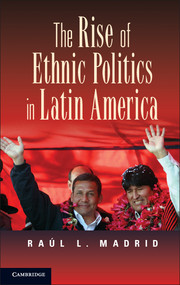Book contents
- Frontmatter
- Contents
- Figures
- Tables
- Acknowledgments
- Abbreviations
- 1 Ethnicity and Ethnopopulism in Latin America
- 2 The Ascent of the MAS in Bolivia
- 3 The Rise and Decline of Pachakutik in Ecuador
- 4 Ethnopopulism without Indigenous Parties in Peru
- 5 Indigenous Parties outside of the Central Andes
- 6 Indigenous Parties and Democracy in the Andes
- 7 Conclusion
- Bibliography
- Index
1 - Ethnicity and Ethnopopulism in Latin America
Published online by Cambridge University Press: 05 December 2012
- Frontmatter
- Contents
- Figures
- Tables
- Acknowledgments
- Abbreviations
- 1 Ethnicity and Ethnopopulism in Latin America
- 2 The Ascent of the MAS in Bolivia
- 3 The Rise and Decline of Pachakutik in Ecuador
- 4 Ethnopopulism without Indigenous Parties in Peru
- 5 Indigenous Parties outside of the Central Andes
- 6 Indigenous Parties and Democracy in the Andes
- 7 Conclusion
- Bibliography
- Index
Summary
It is almost an axiom of politics that ethnicity shapes political participation. In most countries, individuals join political parties, evaluate policies, and vote based in part on their ethnic identification. Political parties, meanwhile, choose candidates, forge alliances, design platforms, and employ certain types of rhetoric and symbols in efforts to attract voters of particular ethnicities.
Latin American countries were traditionally the exception to this rule. Not only were there no important ethnic parties in Latin America, but the dominant non-ethnic parties largely avoided ethnic themes in their campaigns and platforms. Latin American citizens, meanwhile, generally did not vote along ethnic lines. Indigenous people, for example, often split their votes among various parties or voted in ways that were indistinguishable from the rest of the population (Birnir and Van Cott 2007; Madrid 2005a, 2005c; Van Cott 2005).
- Type
- Chapter
- Information
- The Rise of Ethnic Politics in Latin America , pp. 1 - 34Publisher: Cambridge University PressPrint publication year: 2012

